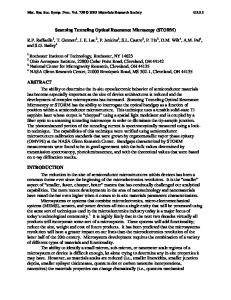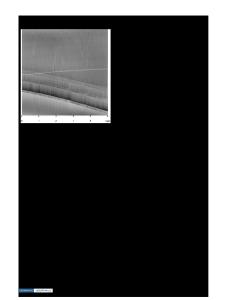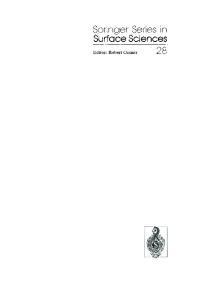Introduction to Scanning Tunneling Microscopy
Scanning tunneling microscopy (STM) was invented by Binnig and Rohrer (see Fig. 2.1) [2,9]. Using the combination of a coarse approach and piezoelectric transducers, a sharp, metallic probing tip is brought into close proximity with the sample. The distan
- PDF / 8,293,328 Bytes
- 30 Pages / 439.37 x 666.142 pts Page_size
- 97 Downloads / 383 Views
Scanning tunneling microscopy (STM) was invented by Binnig and Rohrer (see Fig. 2.1) (2,9). Using the combination of a coarse approach and piezoelectric transducers, a sharp, metallic probing tip is brought into close proximity with the sample. The distance between tip and sample is only a few angstrom units, which means that the electron wave functions of tip and sample start to overlap. A bias voltage between tip and sample causes electrons to tunnel through the barrier. The tunneling current is in the range of pA to nA and is measured with a preamplifier. 1 This signal is the input signal of the feedback loop, which is designed to keep the tunneling current constant during (x, y)-scanning. The output signal is amplified (high voltage amplifier) and connected to the z-piezo. According to the feedback output voltage and the sensitivity of the piezo (typically nm/V) the tunneling tip is moved backwards or forwards and the tunneling current is kept constant during acquisition of the image. This operation mode is called constant current mode. There exist other modes, such as the constant height mode, where the tip is moved at constant height and variations in the current are measured. The (x, y)-movement of the tip is controlled by a computer. The z-position (output of feedback loop) is measured at discrete (x,y)-positions. The data z(xi,Yi) can be displayed in several ways: line-scan image, grey-scale image or colour encoded image. 2 The line-scan image is the most natural way to represent the data, because each line represents the scan of the tip in the fast direction. However, grey-scale images or colour encoded images are more frequently used, because they are better adapted to human pattern recognition. Bright spots represent hillocks or protrusions and dark spots represent valleys or depressions. 1
2
I-V converters are used to convert the tunneling current into a voltage. A possible realisation consists of an operational amplifier (e.g., Burr Brown OPA 111) and a resistor R, where the output voltage is given by Vout = Rlt. With a resistor of the order of R = 100 MQ-1 GQ, currents of the order of nanoamperes, It ~ 1 nA, are measurable. Smaller currents of the order of 0.1 pA are more difficult to measure. Field-effect transistors are needed very close to the tip. Selection of the number of data points is user-defined, e.g., 400 x 400, 500 x 500 or 1000 x 1000. If fast fourier algorithms are to be used, powers of two, 2N, are favourable, e.g., 256 x 256, 512 x 512 or 1024 x 1024.
E. Meyer et al., Scanning Probe Microscopy © Springer-Verlag Berlin Heidelberg 2004
16
2 Introduction to Scanning Tunneling Microscopy
xyz-piezo-scanner
high-voltage amplifier X
feedback
sample
Fig. 2.1. Schematic diagram of the scanning tunneling microscope. An xyz-
piezoelectric scanner moves the tip over the surface. A feedback loop can be used to keep the tunneling current constant
Scan areas are limited by the choice of the piezoelectric scanner and the maximum output voltage Vmax of the high voltage amplifier. With a t
Data Loading...









